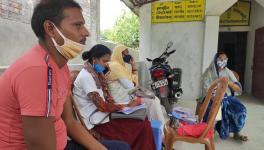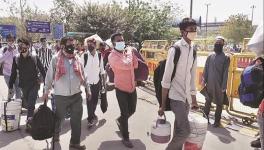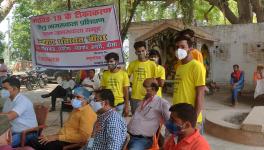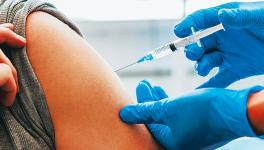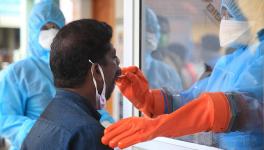Explainer: Black Fungus or Mucormycosis and Reasons Behind Its Unprecedented Rise
With over 5,500 cases and at least 126 deaths due to black fungus or Mucormycosis in India, it has emerged as a serious concern in the past few days. There has been a sudden surge in cases in several states across the country, including Rajasthan, Tamil Nadu, Odisha, Gujarat, and the Union Territory of Chandigarh, which have declared the disease as an epidemic while other states are also considering it.
The unprecedented scale of this disease has led to several questions surrounding this fungal infection, which is often fatal especially among COVID-19 patients, even those who are in the recovery phase. There is also a lot of fear and misinformation around the causes and the effects of disease.
NewsClick approached Prof. Arunaloke Chakrabarti, a prominent mycologisty and head of the Department of Medical Microbiology at PGIMER (Post Graduate Institute of Medical Education and Research), Chandigarh seeking answers on the recent surge in mucormycosis. Prof. Chakrabarti explains the misinterpreted terms involved with the disease and the causes that are leading to the acceleration of cases.
IS IT REALLY ‘BLACK FUNGUS’?
“What we are witnessing is a fungal disease called the “Mucormycosis” and this is caused by fungi belonging to the group known as ‘Mucormycetes’. From the name of the group, the fungal disease is named Mucormycosis. It is not ‘black fungus’ and the term is misleading,” Prof. Chakrabarti said, adding that, “‘black fungus’ belongs to a separate group of fungi known as ‘Dematiaceous’.”
IS MUCORMYCOSIS NEW TO INDIA?
“Mucormycosis is not new in India. The disease is quite prevalent in the country, in fact, India has 70 times higher incidences of the disease in comparison to global data. Many of the fungi belonging to the mucor group are widespread in India. The soil and environment of the country contain the fungi,” Chakrabarti said.
“India, on average, has 50 cases of mucormycosis per year, whereas only 2 to 3 cases are reported in most of the western countries. However, the present situation has witnessed an unprecedented surge and in some places, the number has gone up to 52 cases in just five days. This indicates that the number of cases that were earlier reported in a year, are now occurring within just five days,” he added.
Two research papers, written by Prof. Chakrabarti and his student Hariprasath Prakash, who is now a doctor at the International Higher School of Medicine, Issyk-Kul Regional Campus, Kyrgyzstan, shows the epidemiology of mucormycosis in India and on a global scale. The research paper on India highlights diabetes as the most common risk factor associated with mucormycosis in India, followed by (solid) organ transplant.
WHY THE UNPRECEDENTED SURGE OF THE DISEASE?
According to Chakrabarti there are several factors associated with the surge in mucormycosis, especially among COVID-19 patients.
The first factor highlighted by him was the number of diabetic patients affected by COVID-19 in India. He said that almost 30% of the COVID-10 patients in India are diabetic which is a high-risk factor for mucormycosis.
Also read: Black Fungus Posing New Challenge for Punjab and Haryana
Secondly, the application of steroids in severely ill COVID-19 patients. “While the recommended dose of steroid is 6 milligrams per day, in many cases, it has been found that the steroid is applied to a level of 30 milligrams per day. As the oxygen saturation goes down and a patient develops severity of COVID-19, doctors tend to increase the steroid dose which is associated with mucormycosis,” said Chakrabarti.
He explained, “Steroids can cause a change in the glucose metabolism along with sluggishness in the immune system as steroids are primarily immune suppressants. The heavy use of steroids can lead to an increase in ferritin (a blood protein that contains iron) and free radical release in cells. This can also result in iron coming out to circulation and iron is good food for mucors.”
Third, the SARS-CoV-2 virus can also cause endothelialitis, or damage to the endothelium, which is an interior layer of blood vessels. It is composed of cells which are called endothelial cells. This damage can in turn help the mucor in causing the infection, said Chakrabarti.
Fourth, the environment, both indoor and outdoor, has a higher mucor spore count. This means the spores (microscopic biological particles that allow the fungi to reproduce) belonging to the mucor group are present in the air in high numbers.
Prof Charabarti also told NewsClick that in a soon-to-be-published paper, he and his colleagues have studied the association between COVID-19 and mucormycosis in India during the period of September to December last year. In the study, they had found that mucormycosis cases had gone up in COVID-19 patients in comparison to the average level. However, the current surge is much higher as well as sudden and unprecedented, he said.
EPIDEMIC DECLARATION AND OTHER NECESSARY STEPS
Declaring the disease as an epidemic can be of particular help for zeroing on the exact number of incidences of this disease, Chakrabarti highlighted, adding that the declaration can also come with other precautionary measures and guidelines.
He also insisted that recovered COVID-19 patients, before discharging from hospitals should be provided with guidelines about the early symptoms of mucormycosis and also advised to seek immediate medical help on detection of any such symptoms. “It has been observed generally that after 18 days of COVID-19 diagnosis, the symptoms of mucormycosis begin which starts with one-sided facial pain, to nasal release and loosening of teeth,” he said.
Dr. Hariprasath Prakash suggested that, “The patients should consult doctors immediately on arrival of symptoms. Delay in treatment can lead to severe infections, so prompt medical attention is necessary to reduce the severity of infection.”
Get the latest reports & analysis with people's perspective on Protests, movements & deep analytical videos, discussions of the current affairs in your Telegram app. Subscribe to NewsClick's Telegram channel & get Real-Time updates on stories, as they get published on our website.









